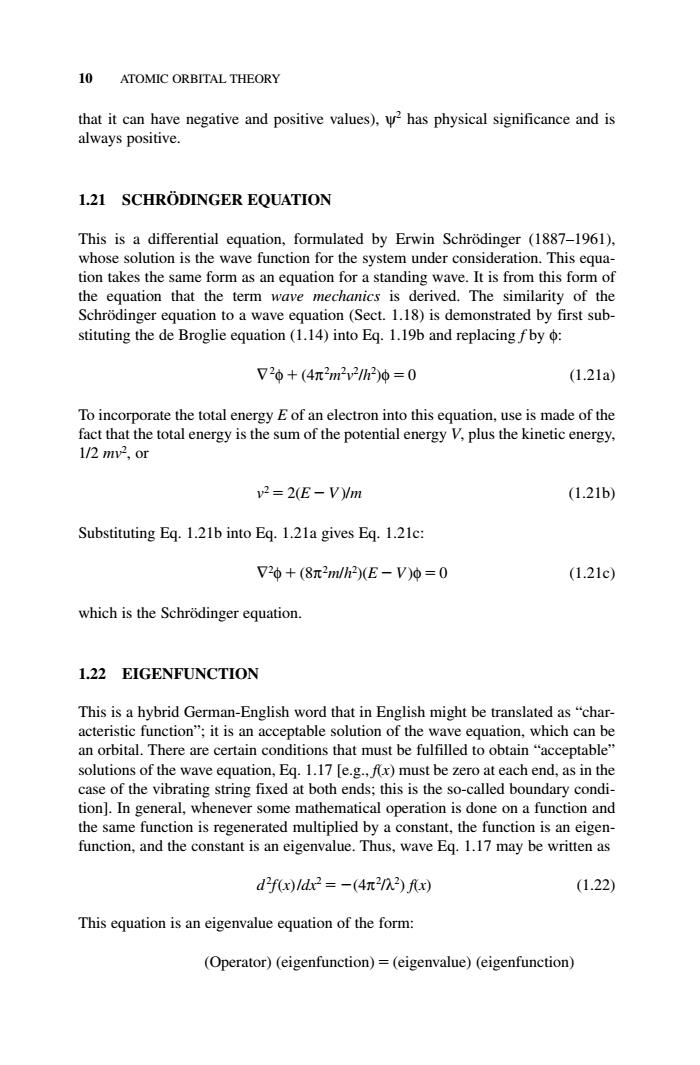正在加载图片...

10 ATOMIC ORBITAL THEORY that it can have negative and positive values).2has physical significance and is always positive. L21 SCHRODINGER EOUATION This is a differential equation,formulated by Erwin Schrodinger (1887-1961) whose solution is the w for the m under co tion takest nsideration.Thisequ orm an equation fo andin Itis fron this for the term wave mechan of the io toa wave cquation (Sect.1.18)isdem stituting the de Broglie equation(1.14)into Eq.1.19b and replacing fby 720+(4π2m21v2h2b=0 (1.21a) To incorporate the total energy Eof a electron into this equation,use is made of the fact that the total energy is the sum of the potential energy V,plus the kinetic energy, 1/2m2,or 2=2(E-V/m (1.21b) Substituting Eq.1.21b into Eq.1.21a gives Eq.1.21c: 720+(8π2mlh2(E-V)0=0 (1.21c) which is the Schrodinger equation. 1.22 EIGENFUNCTION This is a hybrid German-English word that in English might be translated as"char acte on”;itis n,which can solutions of the wave equation,Eq.1.17 [e.g.,fx)must be zero at each end,as in the case of the vibrating string fixed at both ends;this is the so-called boundary condi- tion].In general,whenever some mathematical operation is done on a function and the same function is regenerated multiplied by a constant,the function is an eigen- function,and the constant is an eigenvalue.Thus,wave Eq.1.17 may be written as df)/d2=-(4π2n3)fx (1.22 This equation is an eigenvalue equation of the form: (Operator)(eigenfunction)=(eigenvalue)(eigenfunction) that it can have negative and positive values), ψ2 has physical significance and is always positive. 1.21 SCHRÖDINGER EQUATION This is a differential equation, formulated by Erwin Schrödinger (1887–1961), whose solution is the wave function for the system under consideration. This equation takes the same form as an equation for a standing wave. It is from this form of the equation that the term wave mechanics is derived. The similarity of the Schrödinger equation to a wave equation (Sect. 1.18) is demonstrated by first substituting the de Broglie equation (1.14) into Eq. 1.19b and replacing f by φ: ∇2 φ (4π2 m2 v2 /h2 )φ 0 (1.21a) To incorporate the total energy E of an electron into this equation, use is made of the fact that the total energy is the sum of the potential energy V, plus the kinetic energy, 1/2 mv2 , or v2 2(E V)/m (1.21b) Substituting Eq. 1.21b into Eq. 1.21a gives Eq. 1.21c: ∇2 φ (8π2 m/h2 )(E V)φ 0 (1.21c) which is the Schrödinger equation. 1.22 EIGENFUNCTION This is a hybrid German-English word that in English might be translated as “characteristic function”; it is an acceptable solution of the wave equation, which can be an orbital. There are certain conditions that must be fulfilled to obtain “acceptable” solutions of the wave equation, Eq. 1.17 [e.g., f(x) must be zero at each end, as in the case of the vibrating string fixed at both ends; this is the so-called boundary condition]. In general, whenever some mathematical operation is done on a function and the same function is regenerated multiplied by a constant, the function is an eigenfunction, and the constant is an eigenvalue. Thus, wave Eq. 1.17 may be written as d2 f(x)/dx2 (4π2 /λ2 ) f(x) (1.22) This equation is an eigenvalue equation of the form: (Operator) (eigenfunction) (eigenvalue) (eigenfunction) 10 ATOMIC ORBITAL THEORY c01.qxd 5/17/2005 5:12 PM Page 10���